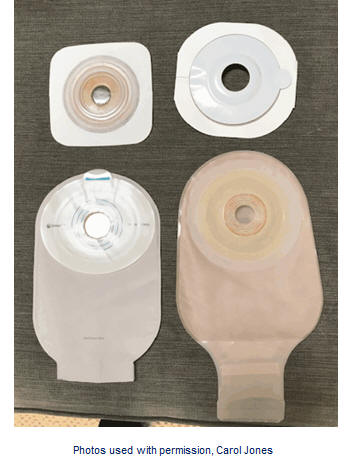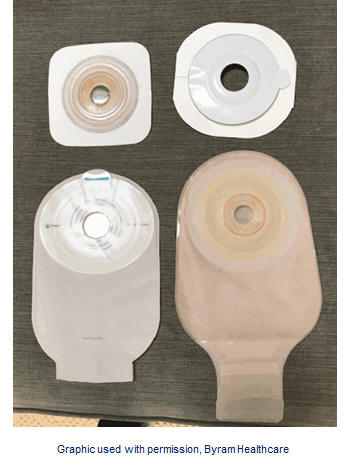|
There are several pouching options available
that can make the reality of living with an
ostomy easier. Let’s take a look at a few of them.
All of the options we are going to talk about
have to do with disposable ostomy bags.
However, reusable bags are available. Only
rarely are patients encountered who currently use or want to
use reusable ostomy supplies, but they are out there. Should
a patient be encountered that uses reusable products, it is
best to consult with a wound and ostomy care nurse, or the
product manufacturer, on the best options for care.
Disposable systems utilize a pouch
(either clear or opaque) to collect the effluent with either
a 1-piece pouch, or 2-piece pouch with skin barrier (or
wafer), to protect the skin. It is usually recommended that
new ostomy patients use a clear bag at first to help with
bag changes. This slide shows an example of a 2-piece system
on the left and a 1-piece on the right.
Skin barriers may be made from pectin,
carboxymethylcellulose, karaya or an extended wear polymer.
Beside the wafer, skin barriers are available in ring,
powder and paste formulations. In the initial post-op
period, a clear pouch is preferred to facilitate the
required frequent stomal assessments, as well as the use of
a cut-to-fit skin barrier to accommodate the changing stoma
size as the post-op swelling decreases. It is usually easier
for patients to center the skin barrier or wafer around the
stoma when a 2-piece system is used, enabling the patient to
change the pouch without disturbing the skin barrier.
•Cut
to fit/precut
Pouches are also available with pre-cut skin
barriers for ease of use, or for a more custom
fit, cut-to-fit barriers.
1-piece pouches are available with either
option, and for patients who like a 2-piece
system, the same options apply.
Generally, patients with an uncomplicated stoma
and peristomal surface may elect to use a
pre-cut skin barrier or wafer. Whether the
patient uses cut-to-fit or pre-cut, the size
should be no more than 1/8” larger than the
diameter of the stoma itself.
|
 |
|
In order to achieve the best seal
possible, pouches and barriers come with flat or
curved (called convex) skin barriers. This allows
for the best possible surface seal that eliminates
leakage. Several factors determine which type of
barrier to use, but generally speaking patients who
have flush or retracted stomas, or bellies with more
fat, folds or scars will want a convex skin barrier,
while flat bellies will work best with a flat
barrier. Convexity also helps to pop the stoma up by
depressing the peristomal skin, and improves
wear-time by decreasing problems associated with
effluent seeping out from under the skin barrier. An
ostomy belt can also be worn to increase convexity
and support.
This slide shows both types of
barriers—as part of a 1-piece pouch, or just the
skin barriers for use in a 2-piece system. For more
pictures of the many options available, visit one of
the ostomy supply company’s websites. |
 |
|